Random thoughts
Wednesday, December 31, 2008
0101001011101010111
Google search nicely reminded me that digital storage is still all about ones and zeros:


Labels: ibm, technology
Wednesday, December 24, 2008
Season's Greetings 2008
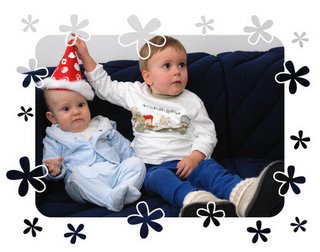
Festivus, Kwanza, Christmas, Hanukkah, Solstice, whatever you celebrate at this time of year: Happy holidays and all the best for the new year!
PS. Daniel wasn't unhappy at all with the hat, except of course when we shot the picture.
Labels: personal
Wednesday, December 10, 2008
I know, I know …
Matt Cutts' blog post today—I’ll try to write something soon, but it’s been busy for the last few days—painfully reminded me that I had a few half-finished blog entries waiting to be completed and published. It’s actually been busy for the last few months, so expect some ancient posts to finally appear over the holidays.
Labels: personal
Tuesday, October 7, 2008
Jamming at the InnovationJam™ 2008

Want to explore how organizations can transform themselves into truly global enterprises of the future? Ready to collaborate with technology and business thought-leaders?
Join the InnovationJam™ 2008.
Labels: business, innovation, technology
Monday, October 6, 2008
Our first car
Guys like to talk about cars. Ever so often when travelling and meeting colleagues abroad, I would get asked what car I drive, and then the conversation shifted to quality of life and how great living in city where public transport actually works would be. For more than twenty years, the network of buses, trams and the underground served us well and still does.
“So you don't drive?” would often be the next question. I do drive, and have accumulated thousands of kilometres on the road on business and holiday trips, with more than 70 car rentals over the years. I also signed up for car sharing a few years ago and enjoyed the convenience of having access to a wide range of vehicles within walking distance from my home.
In 1993 I rented my first car in Vienna for the relocation from the dorm to my apartment. Moving the few belongings back then took multiple trips, and we spent all day moving boxes.
Most of my initial driving experience, oddly enough, was on the left side of the road. While consolidating our European Web hosting infrastructure in North Harbour, I travelled to the UK frequently. The first time I was scared to death, but driving on the left side turned out to be less challenging than I had expected, with the notable exception of multilane roundabouts which I still find tricky. Only once on a business trip to Mulhaddart near Dublin I got onto the wrong side of the road after exiting a petrol station. Fortunately traffic was low and I realized the mistake and changed lanes when I saw a car approaching on “my” lane.
Driving in Australia in 1998 added another challenge: Driving on the left side of the road was easy, I had enough practice with that, but Australian cars also have the controls for wipers and indicators exchanged. I don't want to know how many times I switched the wipers on when making a turn, on a perfectly sunny day.
Did I mention guys care about cars? In August 1999, when the weather forecast for the UK left little hope for clear sight of the total solar eclipse, our friend and hobby astronomer Gurbir Singh decided to abandon the camping ground in the UK and instead take a flight to Austria. Now we had a reason to get serious about eclipse watching! We agreed to meet in Pinkafeld, I bought a tele lens for my camera and a tripod, made reservations at the high school dorm, and ordered a car from Hertz.
Fortunately their reservation system didn't check for availability. When I arrived at the counter a slightly grouchy clerk told me they had to pick up the car from another location first but they would have a car for me shortly. The side effect was that we got a free upgrade. Gurbir liked the car too and acknowledged that working at IBM seemed to pay off if we could afford the latest Volvo model. I think that he was mildly shocked when I mentioned we had rented and didn't actually own a car.
We had a great day in Pinkafeld, finding a good watching spot, (not) learning to juggle, waiting for the wonder of nature. The eclipse was fascinating; everything seemed so calm and peaceful, even the birds turned silent.
On our tour through the Baltic states, Lithuania, Latvia and Estonia, in 2002 something was wrong with our car's theft control, and the car would often refuse to start immediately and require a few tries. No big deal, only once when we were waiting in a long line to board a ferry and the car wouldn't start it was slightly embarrassing. Towards the end of our trip, our vehicle was clamped by the police on Neringa for stopping briefly next to the tourist office(!) Too bad I forgot to take a picture of my first and last clamping so far.
It was on our honeymoon trip to Mauritius in 2005 where we got the smallest car ever, which was fine for day trips without luggage and quite convenient on the narrow roads. We also learned the art of bargaining with car rental staff there. On the first rental, we paid the quoted price minus a “special discount”. The next day, we claimed our customer loyalty bonus and got another discount. On the third rental we appealed to the renter's slogan “We try harder” for an even better deal. The savings weren't substantial, but the bargaining was fun. Of course, for less than the cost of the car alone we could have hired a taxi driver to take us around all day long, but we preferred touring the island on our own.
Fast forward to 2008.
This morning I picked up our new car from the dealer. Our first car. From our renting experiences we pretty much knew what we wanted, a large van, removable extra seats, and reasonable fuel efficiency. We had rented a Seat Alhambra last summer for our trip to Vorarlberg and had been pleased with the vehicle. Our choice fell to the comparable Volkswagen Sharan in the BlueMotion version, which has improved fuel efficiency—6 l/100 km, or 39.2 mpg (US)—and reduced emissions.
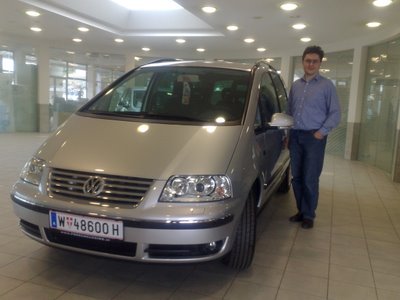
What happened to the couple that happily lived for many years without owning a car? Getting suitable cars had become increasingly difficult, especially around public holidays. Car sizes vary, and ordering a full-size wagon doesn't guarantee you can easily accommodate all passengers and luggage; we once even had to uninvite a friend who was planning to hitch a ride with us. More than once the clerk at the rental company was trying to please me with an upgrade to a luxury car and was disappointed when I only cared about the size of the trunk. No matter how nice a Mercedes E class may be (and it has a fairly big trunk), when it comes to fitting two child seats, two strollers and a few suitcases, there's nothing like a van.
Also we will soon move to a residential area with more distant grocery stores, less frequent public transport connections, and no car sharing station nearby. While I plan to use public transport often still, the car will be convenient for occasional tours to the shopping mall, picking up construction material and furniture, and the like.
So next time someone asks me the question, I will have a different answer.
“So you don't drive?” would often be the next question. I do drive, and have accumulated thousands of kilometres on the road on business and holiday trips, with more than 70 car rentals over the years. I also signed up for car sharing a few years ago and enjoyed the convenience of having access to a wide range of vehicles within walking distance from my home.
In 1993 I rented my first car in Vienna for the relocation from the dorm to my apartment. Moving the few belongings back then took multiple trips, and we spent all day moving boxes.
Most of my initial driving experience, oddly enough, was on the left side of the road. While consolidating our European Web hosting infrastructure in North Harbour, I travelled to the UK frequently. The first time I was scared to death, but driving on the left side turned out to be less challenging than I had expected, with the notable exception of multilane roundabouts which I still find tricky. Only once on a business trip to Mulhaddart near Dublin I got onto the wrong side of the road after exiting a petrol station. Fortunately traffic was low and I realized the mistake and changed lanes when I saw a car approaching on “my” lane.
Driving in Australia in 1998 added another challenge: Driving on the left side of the road was easy, I had enough practice with that, but Australian cars also have the controls for wipers and indicators exchanged. I don't want to know how many times I switched the wipers on when making a turn, on a perfectly sunny day.
Did I mention guys care about cars? In August 1999, when the weather forecast for the UK left little hope for clear sight of the total solar eclipse, our friend and hobby astronomer Gurbir Singh decided to abandon the camping ground in the UK and instead take a flight to Austria. Now we had a reason to get serious about eclipse watching! We agreed to meet in Pinkafeld, I bought a tele lens for my camera and a tripod, made reservations at the high school dorm, and ordered a car from Hertz.
Fortunately their reservation system didn't check for availability. When I arrived at the counter a slightly grouchy clerk told me they had to pick up the car from another location first but they would have a car for me shortly. The side effect was that we got a free upgrade. Gurbir liked the car too and acknowledged that working at IBM seemed to pay off if we could afford the latest Volvo model. I think that he was mildly shocked when I mentioned we had rented and didn't actually own a car.
We had a great day in Pinkafeld, finding a good watching spot, (not) learning to juggle, waiting for the wonder of nature. The eclipse was fascinating; everything seemed so calm and peaceful, even the birds turned silent.
On our tour through the Baltic states, Lithuania, Latvia and Estonia, in 2002 something was wrong with our car's theft control, and the car would often refuse to start immediately and require a few tries. No big deal, only once when we were waiting in a long line to board a ferry and the car wouldn't start it was slightly embarrassing. Towards the end of our trip, our vehicle was clamped by the police on Neringa for stopping briefly next to the tourist office(!) Too bad I forgot to take a picture of my first and last clamping so far.
It was on our honeymoon trip to Mauritius in 2005 where we got the smallest car ever, which was fine for day trips without luggage and quite convenient on the narrow roads. We also learned the art of bargaining with car rental staff there. On the first rental, we paid the quoted price minus a “special discount”. The next day, we claimed our customer loyalty bonus and got another discount. On the third rental we appealed to the renter's slogan “We try harder” for an even better deal. The savings weren't substantial, but the bargaining was fun. Of course, for less than the cost of the car alone we could have hired a taxi driver to take us around all day long, but we preferred touring the island on our own.
Fast forward to 2008.
This morning I picked up our new car from the dealer. Our first car. From our renting experiences we pretty much knew what we wanted, a large van, removable extra seats, and reasonable fuel efficiency. We had rented a Seat Alhambra last summer for our trip to Vorarlberg and had been pleased with the vehicle. Our choice fell to the comparable Volkswagen Sharan in the BlueMotion version, which has improved fuel efficiency—6 l/100 km, or 39.2 mpg (US)—and reduced emissions.

What happened to the couple that happily lived for many years without owning a car? Getting suitable cars had become increasingly difficult, especially around public holidays. Car sizes vary, and ordering a full-size wagon doesn't guarantee you can easily accommodate all passengers and luggage; we once even had to uninvite a friend who was planning to hitch a ride with us. More than once the clerk at the rental company was trying to please me with an upgrade to a luxury car and was disappointed when I only cared about the size of the trunk. No matter how nice a Mercedes E class may be (and it has a fairly big trunk), when it comes to fitting two child seats, two strollers and a few suitcases, there's nothing like a van.
Also we will soon move to a residential area with more distant grocery stores, less frequent public transport connections, and no car sharing station nearby. While I plan to use public transport often still, the car will be convenient for occasional tours to the shopping mall, picking up construction material and furniture, and the like.
So next time someone asks me the question, I will have a different answer.
Wednesday, September 3, 2008
Google Chrome first impressions
Does the world need another Web browser? Probably not, most people are reasonably happy with Firefox (or SeaMonkey), Safari and Internet Explorer, and a wide range of less known specialized browsers.
But then of course it's hard to ignore a new browser when it's launched by Google. Matt Cutts quickly blogged about the Google Chrome announcement and conspiracy theories, and the search engine guessing feature in particular caught my interest.
www.ibm.com has supported OpenSearch for years and it's good to see a browser finally making good use of the OpenSearch description and providing access to custom search engines using keyboard navigation. With the OpenSearch definition for IBM Search enabled, typing ibm.com Green IT selects IBM Search as the preferred engine for that search:
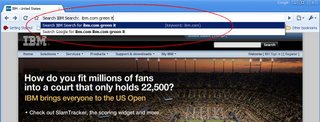
The same can be achieved in Firefox with keywords, albeit not as easily.
Rendering of XML content including RSS news feeds leaves much to be desired. Hopefully Google will add full XML rendering support and integrate a feed reader soon.
Incognito browsing is another neat idea, it won't help much to preserve your privacy but could be useful for testing when you don't want all the test pages to clutter your browser history.
One prerequisite for me using Chrome is support by RoboForm which keeps track of all my accounts and passwords. RoboForm does not work with Safari but hopefully with Chrome being open source will support this browser. Web development tools that work with Chrome will be the other deal breaker.
In the meantime I will continue to experiment with Chrome and see what else Google's latest brainchild has to offer.
But then of course it's hard to ignore a new browser when it's launched by Google. Matt Cutts quickly blogged about the Google Chrome announcement and conspiracy theories, and the search engine guessing feature in particular caught my interest.
www.ibm.com has supported OpenSearch for years and it's good to see a browser finally making good use of the OpenSearch description and providing access to custom search engines using keyboard navigation. With the OpenSearch definition for IBM Search enabled, typing ibm.com Green IT selects IBM Search as the preferred engine for that search:

The same can be achieved in Firefox with keywords, albeit not as easily.
Rendering of XML content including RSS news feeds leaves much to be desired. Hopefully Google will add full XML rendering support and integrate a feed reader soon.
Incognito browsing is another neat idea, it won't help much to preserve your privacy but could be useful for testing when you don't want all the test pages to clutter your browser history.
One prerequisite for me using Chrome is support by RoboForm which keeps track of all my accounts and passwords. RoboForm does not work with Safari but hopefully with Chrome being open source will support this browser. Web development tools that work with Chrome will be the other deal breaker.
In the meantime I will continue to experiment with Chrome and see what else Google's latest brainchild has to offer.
Labels: technology, webdevelopment
Thursday, August 14, 2008
'undefined' is null or not an object
Tracking down a nasty bug in some JavaScript code I wrote has taken me a while. Granted, the actual script was slightly more complex and much longer, and I may be somewhat out of practice too.
This script worked perfectly fine in Firefox, in Seamonkey, even in Opera but failed miserably in Internet Explorer with the not so helpful error message 'undefined' is null or not an object:
Can you see the problem (and why this works in Mozilla)?
This script worked perfectly fine in Firefox, in Seamonkey, even in Opera but failed miserably in Internet Explorer with the not so helpful error message 'undefined' is null or not an object:
var items = [
{id: 'type', condition: !document.referrer},
{id: 'link', condition: !!document.referrer},
];
for (var i=0; i < items.length; i++) {
var item = items[i];
if(typeof(item.condition) == 'undefined' || item.condition) { // Bang!
// do something useful
}
Can you see the problem (and why this works in Mozilla)?
Labels: javascript, webdevelopment
Wednesday, July 30, 2008
House update
Almost two months ago I had mentioned that we were planning to buy a house and had made an offer. The negotiations and the paperwork took a while. We finally agreed on the deal and signed the contract earlier this month, and received the keys yesterday.
Elias was very excited as he moved around the house (he had slept through the two times we had seen the place before) and seems to like it. He quickly made friends with the two children next door, too.
The house was completely renovated not too long ago, so only minor adaptations are required. We plan to furnish the house within a month or two and move in by autumn.
Needless to say that we are very excited and happy about this and looking forward to our new home.
Elias was very excited as he moved around the house (he had slept through the two times we had seen the place before) and seems to like it. He quickly made friends with the two children next door, too.
The house was completely renovated not too long ago, so only minor adaptations are required. We plan to furnish the house within a month or two and move in by autumn.
Needless to say that we are very excited and happy about this and looking forward to our new home.
Thursday, July 10, 2008
Microsoft DNS patch KB951748 secures Internet access too well
The latest Microsoft DNS patch improves security too well. The update appears to be incompatible with Check Point's hugely popular ZoneAlarm firewall and possibly other firewall products, and results in complete loss of Internet access.
After a lengthy failed attempt to diagnose a family member's “my Internet no longer works” problem over the phone I saw the BugTraq alert “Microsoft DNS patch KB951748 incompatible with Zonealarm” late at night. Sure enough, uninstalling the update nicely resolved the problem.
The other possible workaround, turning off the firewall completely, would be more risky than living with the spoofing vulnerability until this incompatibilty gets fixed.
After a lengthy failed attempt to diagnose a family member's “my Internet no longer works” problem over the phone I saw the BugTraq alert “Microsoft DNS patch KB951748 incompatible with Zonealarm” late at night. Sure enough, uninstalling the update nicely resolved the problem.
The other possible workaround, turning off the firewall completely, would be more risky than living with the spoofing vulnerability until this incompatibilty gets fixed.
Labels: technology, windows
Tuesday, July 8, 2008
What do all the numbers mean?
Who the heck is Charlie O'Donnell? I don't know, but somehow (more precisely, from Ed Costello's bookmarks on del.icio.us) I stumbled upon his blog post An experiment: Who's really out there and how do you measure influence?
When Feedburner reports 2686 readers, does that mean 2686 folks actually read the blog, or once subscribed to it and never came back? So Charlie is running an experiment to determine who's actually reading, how people find out about the blog etc. and as an aside get really popular. This is social marketing at its best, so let's pass on the word and see just how popular we can get this.
Link to the post: http://www.thisisgoingtobebig.com/2008/07/an-experiment-w.html
When Feedburner reports 2686 readers, does that mean 2686 folks actually read the blog, or once subscribed to it and never came back? So Charlie is running an experiment to determine who's actually reading, how people find out about the blog etc. and as an aside get really popular. This is social marketing at its best, so let's pass on the word and see just how popular we can get this.
Link to the post: http://www.thisisgoingtobebig.com/2008/07/an-experiment-w.html
Labels: metrics, technology
Sunday, June 29, 2008
Unknown error in XPath
Alright, I do have a reputation for putting Websites to the test, but they seem to break even if when I just innocently try to use them:

I guess this was the perfect greeting card for me, better then the cute dog blowing up a birthday cake which was supposed to show :-)

I guess this was the perfect greeting card for me, better then the cute dog blowing up a birthday cake which was supposed to show :-)
Friday, June 20, 2008
Happy anniversary, Marriott Rewards!
Marriott Rewards celebrates its 25th anniversary. The customer loyalty program was also recognized as the best award program by the Freddie Awards, and in my humble opinion rightly so.
High class properties around the globe, including hotels and extended stay suites, a painless online reservation system that doesn't require me to memorize lengthy membership numbers and company rate codes and loyalty to customers—my points never expired even when I didn't stay with them for a while—make Marriott Rewards a great program.
By contrast, Hilton HHonors not only forfeited my points but also canceled my HHonors account, in line with their terms of use, when I failed to accumulate points while the property I had usually stayed at was closed for renovation. (As a gesture of goodwill they did offer extra points for additional stays to compensate for the loss.)
Most customer loyalty programs are free. One notable exception is the Accor Favorite Guest program, which offers reductions on standard rates, reservation priority, gift vouchers and partner advantages like other programs do, “for only 130 euros per year”.
The quality of the customer loyalty programs may not be the most important factor when choosing accommodation, but a good program certainly helps with the decision where to stay.
High class properties around the globe, including hotels and extended stay suites, a painless online reservation system that doesn't require me to memorize lengthy membership numbers and company rate codes and loyalty to customers—my points never expired even when I didn't stay with them for a while—make Marriott Rewards a great program.
By contrast, Hilton HHonors not only forfeited my points but also canceled my HHonors account, in line with their terms of use, when I failed to accumulate points while the property I had usually stayed at was closed for renovation. (As a gesture of goodwill they did offer extra points for additional stays to compensate for the loss.)
Most customer loyalty programs are free. One notable exception is the Accor Favorite Guest program, which offers reductions on standard rates, reservation priority, gift vouchers and partner advantages like other programs do, “for only 130 euros per year”.
The quality of the customer loyalty programs may not be the most important factor when choosing accommodation, but a good program certainly helps with the decision where to stay.
Firefox 3
The Mozilla project released Firefox 3 on June 17 with an attempt to set the world record in software downloads per day.

While I consider raw traffic numbers only mildly useful and the hunt for traffic records somewhat old-fashioned (when IBM did run the Olympics Websites we would report record traffic numbers, and with the technology available back then the numbers were impressive, but that was in the 1990ies) I gladly did my part to set the world record. I mean, how often do you get a chance to be part of a world record, even if your contribution is only 1/8290545.
I even installed Firefox 3 :-) and for most parts have been satisfied with the result. The only complaint I have is that the installation overwrote the previously installed Firefox 2 despite placing the new version in a different directory, and sure enough some extensions were considered incompatible and therefore disabled.
Multiple Internet Explorer versions can coexist on the same machine thanks to the wonderful Multiple IE installer, can we please get an easy and automated way to run multiple versions of Firefox without fiddling with profiles?

While I consider raw traffic numbers only mildly useful and the hunt for traffic records somewhat old-fashioned (when IBM did run the Olympics Websites we would report record traffic numbers, and with the technology available back then the numbers were impressive, but that was in the 1990ies) I gladly did my part to set the world record. I mean, how often do you get a chance to be part of a world record, even if your contribution is only 1/8290545.
I even installed Firefox 3 :-) and for most parts have been satisfied with the result. The only complaint I have is that the installation overwrote the previously installed Firefox 2 despite placing the new version in a different directory, and sure enough some extensions were considered incompatible and therefore disabled.
Multiple Internet Explorer versions can coexist on the same machine thanks to the wonderful Multiple IE installer, can we please get an easy and automated way to run multiple versions of Firefox without fiddling with profiles?
Labels: technology, webdevelopment, windows
At home with two boys
It is almost a week now that the whole family has been back home, and we are slowly getting into a routine of handling two boys.
After a few days at the AKH Wien, Daniel was transfered back to the birth clinic on Thursday, and we returned home on the weekend.
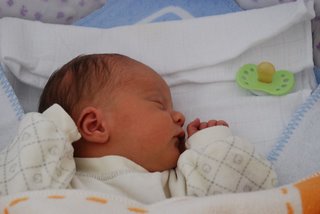
Daniel is doing great; he mostly sleeps through the day and becomes more demanding at night (so please don't ask if we get much sleep!)
We greatly appreciate all the help we received from friends and family, a big thank you to Helga and Thomas who took care of Elias at 5 a.m. as we went to the clinic, Simone and Michael for having Elias over the weekend and my in-laws for looking after Elias while we were away.
Thanks also for all the kind wishes and greeting cards!
After a few days at the AKH Wien, Daniel was transfered back to the birth clinic on Thursday, and we returned home on the weekend.

Daniel is doing great; he mostly sleeps through the day and becomes more demanding at night (so please don't ask if we get much sleep!)
We greatly appreciate all the help we received from friends and family, a big thank you to Helga and Thomas who took care of Elias at 5 a.m. as we went to the clinic, Simone and Michael for having Elias over the weekend and my in-laws for looking after Elias while we were away.
Thanks also for all the kind wishes and greeting cards!
Monday, June 9, 2008
Daniel Nikolas is here
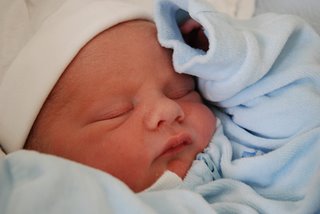
Our hearts are full of love for Daniel Nikolas. Our boy arrived on Saturday, June 7 2008 at 5:26 a.m., slightly earlier than expected.
Little Daniel is currently at the AKH Wien for medical observation. The whole family is doing well, and Elias is excited about the arrival of "baby Daniel, baby Daniel, baby Daniel". More later, now back to the hospital.
Friday, June 6, 2008
EURO 2008 in Austria and Switzerland about to start
The EURO 2008 will start tomorrow night with the opening matches in Basel and Geneva, followed by matches in Vienna and Klagenfurt on Sunday, not that I am interested in soccer or suddenly became overly patriotic (which probably wouldn't be a good idea based on what I read about our soccer team :-))
The only reason I care really is that our apartments are close to one of the venues, the Ernst Happel stadium, and we expect to see and hear crowds of fans passing by.
One of the positive side effects of the event was an improvement to the already excellent public transport system. The U2 metro line was extended to the stadium and will be extended further in the coming years. The upcoming event certainly added a little pressure to complete the extension on time.
The most notable change, however, has been the plethora of cars decorated with national flags, mostly Austrian, some foreign, and a few mixed. Signs to the stadium and the fan zone in the city center have popped up everywhere over the last few days, all kinds of merchandise are offered (anyone care for a football shaped loaf of EURO 2008 bread?), additional waste bins have been installed, and even the sausage stand around the corner looks much more colorful and inviting than usual.
We had actually planned to leave Vienna for the duration of the event and go on vacation but had to change our plans, more on that later. Let's hope for some exciting matches to please the fans and most importantly for a peaceful event.
To probe further: Official UEFA EURO 2008 Website
The only reason I care really is that our apartments are close to one of the venues, the Ernst Happel stadium, and we expect to see and hear crowds of fans passing by.
One of the positive side effects of the event was an improvement to the already excellent public transport system. The U2 metro line was extended to the stadium and will be extended further in the coming years. The upcoming event certainly added a little pressure to complete the extension on time.
The most notable change, however, has been the plethora of cars decorated with national flags, mostly Austrian, some foreign, and a few mixed. Signs to the stadium and the fan zone in the city center have popped up everywhere over the last few days, all kinds of merchandise are offered (anyone care for a football shaped loaf of EURO 2008 bread?), additional waste bins have been installed, and even the sausage stand around the corner looks much more colorful and inviting than usual.
We had actually planned to leave Vienna for the duration of the event and go on vacation but had to change our plans, more on that later. Let's hope for some exciting matches to please the fans and most importantly for a peaceful event.
To probe further: Official UEFA EURO 2008 Website
Sunday, June 1, 2008
Buying a house
After many years of searching, we may have finally found a new home. It is a detached house in residential area of the 13th district of Vienna, not as close to the city as we currently live but still acceptable. Supermarkets, a playground and tram and bus stops are all within easy walking distance, too.
We did view the house twice and made an offer last week. The owner has accepted in principle, so now we need to work out the contract details. We are very excited about this and will post details and pictures as soon as we close the deal.
We did view the house twice and made an offer last week. The owner has accepted in principle, so now we need to work out the contract details. We are very excited about this and will post details and pictures as soon as we close the deal.
Thursday, April 24, 2008
PowerPoint: No comma, please
A colleague recently showed me a strange problem with Microsoft Office: When inserting a hyperlink in a PowerPoint presentation, one of the available options is linking to another page in the same document:
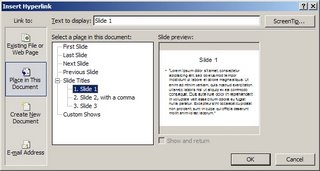
This seemed to work nicely for most slides but not for the particular slide he was trying to link to, and PowerPoint would not even show a preview in the hyperlink dialog box:
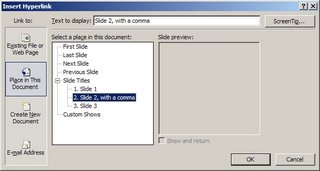
The programmer in me quickly scanned through the slide looking for “suspicious” elements, the only thing that caught my attention though was an innocent looking comma.
Turns out the comma is indeed the culprit, and the bug is well-documented in the Microsoft knowledge base: The hyperlink to a slide does not work when a comma is contained in the title of a slide presentation in PowerPoint.
Removing the comma, placing the hyperlink and then adding the comma back does seem to do the trick. Or, just don't use a comma.

This seemed to work nicely for most slides but not for the particular slide he was trying to link to, and PowerPoint would not even show a preview in the hyperlink dialog box:

The programmer in me quickly scanned through the slide looking for “suspicious” elements, the only thing that caught my attention though was an innocent looking comma.
Turns out the comma is indeed the culprit, and the bug is well-documented in the Microsoft knowledge base: The hyperlink to a slide does not work when a comma is contained in the title of a slide presentation in PowerPoint.
Removing the comma, placing the hyperlink and then adding the comma back does seem to do the trick. Or, just don't use a comma.
Labels: technology, windows
Saturday, April 19, 2008
Usability: When forward goes backward
The IEEE Computer Society recently invited members to participate in a survey. Admittedly, since taking on my current job I have developed a strange desire for taking surveys to see what others are doing and what we could learn from them.
Besides being too long (read: I stopped answering the survey once I figured this would take me longer than I was willing to click through question after question) this particular survey had an interesting usability problem: For some reason, the forward link to move to the next question is on the left, whereas the backward link is on the right:
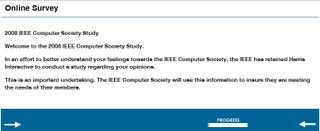
The designer may have considered reading order or attempted to make the site more accessible by putting the more frequently used option first, which would be commendable, but the result is a poor navigation scheme. I would be curious to know how many respondents get frustrated about this and abandon the survey.
Besides being too long (read: I stopped answering the survey once I figured this would take me longer than I was willing to click through question after question) this particular survey had an interesting usability problem: For some reason, the forward link to move to the next question is on the left, whereas the backward link is on the right:

The designer may have considered reading order or attempted to make the site more accessible by putting the more frequently used option first, which would be commendable, but the result is a poor navigation scheme. I would be curious to know how many respondents get frustrated about this and abandon the survey.
Labels: usability
Friday, April 18, 2008
VPS, PDC, DVB, EPG—Why can VCRs not just work?
Video cassette recorders (VCR) have a long-standing reputation for being difficult to use (searching for VCR and usability returns some 90,000 results on Google).
In the early days setting the timer right may have been challenging, and too often the program would change or fall behind and the tape would contain a different program, or a cut off film. Then came the Video Programming System (VPS) and ShowView, which made programming VCRs easy and greatly increased the likelihood of recording the desired program, and later Programme Delivery Control (PDC).
Everything seemed fine until last year when a decision was made to discontinue analog TV broadcasting in Austria and switching to Digial Video Broadcasting (DVB-T). The television system had maintained backwards compatibility with the great many enhancements over the years, from black-and-white to color, from mono to stereo and dual channel audio. This time, however, new equipment would be needed in the form of DVB-T receivers, and of course that means one for each TV set and recorder.
Our first attempt with a twin receiver bought on EBay was a dismal failure. The device seemed malfunctioning and vendor support was non-existent (more precisely, we were unable to locate the vendor, which seemed to have gone out of business). We happily lived for a few weeks without television.
Eventually we got a nice Sony HXD-870 HD/DVD recorder with built-in DVB-T tuner and at first were quite happy. Setting up the device was easy (except for the fact it did not recognize Austria as a country) and we were back to receiving and recording TV programs.
Although the new recorder supports VPS/PDC it does so only from analog sources, which are no longer available, but not from the digital signal despite the fact that the VPS signal is sent digitally as well. The new Electronic Program Guide (EPG) is convenient, but there is no way to tell the recorder to start when the program starts. Instead you can manually tweak the time range to increase the likelihood of recording the full program.
If that wasn't bad enough already, when we switched to daylight savings time, or summer time as it's called here, the program guide appeared to be off by one hour and so were all recordings. There is a timezone menu but toggling daylight savings time on and off did not seem to make any difference.
The Sony support Website was less than helpful. The only firmware upgrade was for the UK version of the recorder and fixed an unrelated problem that we hadn't encountered.
Fortunately a kind soul owning the same device came to rescue and shared instructions how to overcome this bug by switching to a different time zone and then rebooting the recorder. We have since been running on Helsinki time and had mixed success in recording programs.
With all the advances in technology and three-letter acronym features, we are essentially back to the functionality in the early days of video recording, manually setting times and hoping for the program to stay on schedule.
Why can VCRs not just work?
In the early days setting the timer right may have been challenging, and too often the program would change or fall behind and the tape would contain a different program, or a cut off film. Then came the Video Programming System (VPS) and ShowView, which made programming VCRs easy and greatly increased the likelihood of recording the desired program, and later Programme Delivery Control (PDC).
Everything seemed fine until last year when a decision was made to discontinue analog TV broadcasting in Austria and switching to Digial Video Broadcasting (DVB-T). The television system had maintained backwards compatibility with the great many enhancements over the years, from black-and-white to color, from mono to stereo and dual channel audio. This time, however, new equipment would be needed in the form of DVB-T receivers, and of course that means one for each TV set and recorder.
Our first attempt with a twin receiver bought on EBay was a dismal failure. The device seemed malfunctioning and vendor support was non-existent (more precisely, we were unable to locate the vendor, which seemed to have gone out of business). We happily lived for a few weeks without television.
Eventually we got a nice Sony HXD-870 HD/DVD recorder with built-in DVB-T tuner and at first were quite happy. Setting up the device was easy (except for the fact it did not recognize Austria as a country) and we were back to receiving and recording TV programs.
Although the new recorder supports VPS/PDC it does so only from analog sources, which are no longer available, but not from the digital signal despite the fact that the VPS signal is sent digitally as well. The new Electronic Program Guide (EPG) is convenient, but there is no way to tell the recorder to start when the program starts. Instead you can manually tweak the time range to increase the likelihood of recording the full program.
If that wasn't bad enough already, when we switched to daylight savings time, or summer time as it's called here, the program guide appeared to be off by one hour and so were all recordings. There is a timezone menu but toggling daylight savings time on and off did not seem to make any difference.
The Sony support Website was less than helpful. The only firmware upgrade was for the UK version of the recorder and fixed an unrelated problem that we hadn't encountered.
Fortunately a kind soul owning the same device came to rescue and shared instructions how to overcome this bug by switching to a different time zone and then rebooting the recorder. We have since been running on Helsinki time and had mixed success in recording programs.
With all the advances in technology and three-letter acronym features, we are essentially back to the functionality in the early days of video recording, manually setting times and hoping for the program to stay on schedule.
Why can VCRs not just work?
Labels: technology, usability